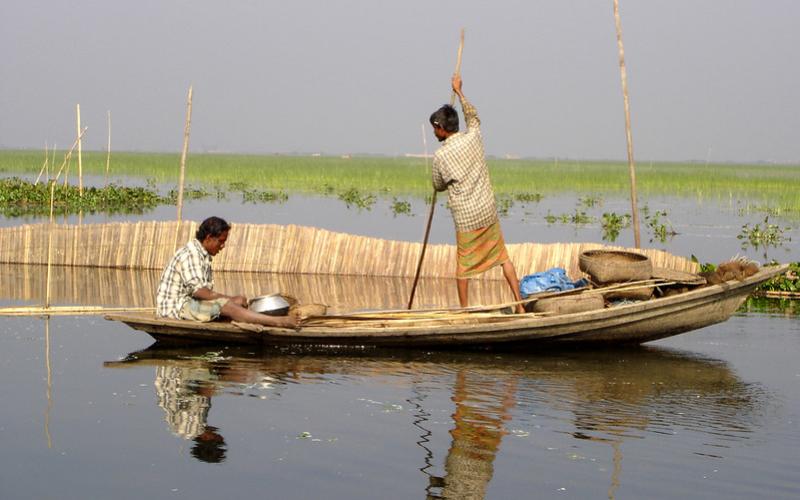
In this op-ed, WorldFish scientist Dr. Peerzadi Rumana Hossain explains how aquatic food innovations in Bangladesh can foster resilient, nature-positive food systems in the face of climate change.
Food systems use half of the Earth's biocapacity and account for over a quarter of the global ecological footprint. Our methods of producing, supplying and consuming food are threatened by climate change while paradoxically contributing to carbon emissions. As demand for food production increases by the world's growing population, ensuring food and nutrition security within planetary boundaries requires urgent climate-smart food systems.
Aquatic foods—animals, plants and microorganisms harvested and grown from water—have a significant role in sustainably feeding and nourishing the world while reducing food systems’ ecological footprint. Globally, aquaculture increasingly dominates aquatic food production systems, and fish and other aquatic foods are among the most traded food commodities globally. Sustainable aquaculture produces less greenhouse gases than land-based livestock and crop-agriculture. Most importantly, aquatic foods are rich in protein and contain essential micronutrients that other food commodities cannot easily substitute. Often the most accessible and acceptable nutritious foods for many vulnerable communities in low- and middle-income countries they offer solutions for improving sustainable healthy diets.
However, climate change-induced natural shocks and disasters, including erratic rain, floods, cyclones, droughts and heatwaves, as well as climate-induced warming, ocean acidification, sea-level rise, saltwater intrusion and salinization, are already affecting aquatic food systems and causing havoc for aquatic food producers worldwide.
Climate-smart innovations and practices that build resilience and sustainability in aquatic food systems need to be enhanced at scale to tackle these impacts. Prioritizing sustainable, inclusive and climate-resilient aquatic foods production, supply chains and consumption patterns are key to overcome challenges and accelerate efforts on achieving UN Sustainable Development Goals.
Bangladesh as a role model for climate-smart innovations in aquatic food systems

Climate-smart innovations and practices in Bangladesh can be a model for how to sustainably produce nutritious aquatic foods while adapting to a changing environment. With the world's largest flooded wetland and rich marine biodiversity, Bangladesh is considered one the most suitable regions for aquatic food production in the world and simultaneously is one of the most vulnerable countries to climate change.
The country is ranked as the second most vulnerable in Asia, and the impacts of climate change are increasingly threatening freshwater aquaculture. It has a low adaptive capacity to cope with the effects of climate change, mainly extreme weather events, which have been growing in frequency and intensity and sea level rise, that lead to salt water intrusion and brackish water. It is evident that climate change poses a significant threat to aquatic food production systems and potentially affects the country’s food and nutrition security, as aquatic foods account for 60 percent of all animal protein intake in the country.
Many prospective climate-smart innovations are already underway, but these will require urgent investment for scaling to meet the challenges in time.
Climate information services for aquaculture farmers
Climate information services (CIS) are increasingly in demand to assist farmers in managing risks associated with climate variability in food production. However, there are significant gaps in the availability and accessibility of these services, especially in aquatic food production in developing countries. WorldFish has developed a decision framework to reduce temperature and rainfall variability-induced risks in aquaculture operations under the project CaFFSA, which provides climate information services to farmers.
The current work represents a valuable first step in delivering clear, actionable information to fish farmers to manage climate risks, and thus reach the broader goals of ensuring livelihood, food and nutrition security. Armed with information, farmers can manage disease risks, reduce fish stress and mortality and mitigate climate-induced losses, all of which ensure better profits for smallholder farmers and provide food and nutrition security to the population.
It is expected that the decision framework will continue growing with more climate-sensitive decision points and additional fish species, becoming a mature climate service tool over time. The provision of climate services can act as a risk reduction intervention, and the reduced risk levels act as a mechanism to increase investments in aquaculture by small farmers. Creating the reported decision framework is a crucial step in realizing this promising opportunity and acts as a template for similar services in other countries.
Integrating coastal land and saltwater food production systems
Being situated in the world’s largest delta, Bangladesh's coastal regions are vulnerable to sea level rise. Traditionally, coastal communities farm salt, which is primarily a seasonal activity during winter and the pre-monsoon season. However, the practice is being affected by climatic changes such as pre-monsoon rainfall anomalies, cyclonic surges, tidal inundation, floods and cold weather. These may shorten the salt production season, which is reducing employment options hitting household income. As the salt production area is highly saline and salt cannot be produced year-round, WorldFish has introduced brine shrimp culture and production systems integrated with salt and aquaculture, allowing farmers to continue production and earn income. This integrated aquatic food-production system using coastal land and saltwater opens a new frontier for climate-resilient aquatic food production.
Farming seaweed: nutrient-rich and a low-cost carbon sink

WorldFish's research on seaweed reveals that food and nutrition security could be enhanced through the introduction of salt-tolerant seaweed crops in coastal wetland systems to increase biodiversity while acting as low-cost carbon sinks. Compared to fishing, growing seaweed is simpler–the equipment is less expensive, and seaweed requires no feed and is easy to harvest. Most importantly, seaweed species help us to utilize the saltwater ecosystem as a productive aquatic food system.
The socioeconomic status of fishers during annual fishing bans discloses the need for more research on seaweed and other salt-tolerant aquatic plants like Samphire. These aquatic resources can only not act as a climate adaptation option but also as a mitigation measure as they absorb atmospheric carbon.
Enhanced capacity of fish farmers and their support agents
Training dialogues for new technologies, best management practices and information services along with climate, nutrition and gender-responsive advisories is a proven strategy for enhancing the capacity of fish farmers and their support agents. WorldFish's IDEA project has already started to provide training sessions for both private companies and local service providers to reach large numbers of fish farmers in the drought-prone northwestern and western climactic zones of Bangladesh. The project is enhancing their service provision capacities for pond management, water quality, seed quality, feed quality and climate-sensitive management decisions; developing their knowledge on fish food's nutrition value; and empowering women in a complex social context through aquaculture operations.
In addition, the WorldFish-led IDEA project developed a digital platform specifically for the aquaculture community, which is primarily based on Facebook and WhatsApp, so that information and knowledge can be shared immediately and in multiple visual forms. The formation of a digital community for fish farming will allow direct communication with beneficiaries. Simultaneously, it will also generate real-time farm-level data that can help WorldFish and its partners understand the extent of their outreach. The comprehensive training model developed by WorldFish under this project has the potential for horizontal expansion to other climatic zones (flood-prone/salinity prone) of the country to enhance fish farmers and their support agents to deal with adverse hydro-climatic and socioeconomic conditions.
Climate-smart and nutrition-sensitive fisheries and aquaculture management

WorldFish has implemented climate-smart and nutrition-sensitive approaches to fisheries and aquaculture management, as one of the technical partners of Suchana—a large-scale development program being implemented in north-eastern Bangladesh by a consortium of technical, implementing and research agencies. In aquaculture systems, WorldFish introduced large and fast-growing fish fingerlings to ponds alongside small indigenous fingerling species and agricultural crops, which is nutrition-smart.
Fish preservation methods and new technologies for harvesting were also introduced. The introduction of the gill net allowed women to harvest fish regularly and subsistence fishing, including fish drying interventions, maintained the fish supply even in the dry/lean period following the monsoon season. All these contribute to the increased production and inclusion of a nutrient-rich fish diet. This is an ideal example of how we can design locally-led climate-smart adaptation techniques focused on the local hydro-climatic and socioeconomic conditions.
Reducing our footprint
Humanity can reduce its carbon footprint by shifting food intake behavior to an aquatic food-based protein diet. To sustainably use earth’s resources, and stay within its biocapacity, we need to shrink food systems' carbon footprint by enhancing innovative, climate-smart and locally-led adaptation interventions for aquatic food production systems at scale. Bangladesh can be an ideal example to follow. Transforming aquatic food systems in this way will require a considerable infusion of knowledge, innovation, tools and continued investment that will aid humanity to reach the broader goals of social and environmental security.
Relevant publications:
- Developing Climate Information Services for Aquaculture in Bangladesh: A Decision Framework for Managing Temperature and Rainfall Variability-Induced Risks
- Enhancing the capacity of fish farmers and their support agents in understanding and using climate risk information at scale in Bangladesh
- Delivering climate information services for climate-smart fish pond and disease management to more than 1 million fish farmers in the State of Odisha, India
- A training dialogue report: Introduction to Climate Services for Aquaculture
- Impacts of climate change on coastal ecosystems of Bangladesh
- Adaptation pathways to cope with salinization in the south-west coastal region of Bangladesh
Relevant posts:
- A Training Dialogue on Introduction to Climate Information Services for Aquaculture in Bangladesh
- Climate-smart innovations can boost aquatic food systems productivity in Bangladesh, says climate change, expert
- A virtual stakeholder workshop on enhancing climate information services for aquaculture at scale
- A session on Climate information services for fisheries and aquaculture at Global Gobeshona Conference on Research into Action
